The thing about Jags is the most iconic ones have never been practical cars. Thank god.
They have always been beautiful cars.
The chromed leaper on the hood, for instance, being more beautiful all by itself than the entirety of most other cars.
The trick is making practical beautiful.
It’s not isn’t as fetching to view – when you first view it – as an XF or F-Type, perhaps. But it has a kind of beauty that is rare among five-door crossovers.
The kind of beauty you only see from behind the wheel.
What It Is
The F-Pace looks like a medium-small, five-door crossover – but it’s actually a Jaguar . . . under its skin.
Specifically, a Jaguar XF – with which the F-Pace shares the same D7 Premium Lightweight Architecture and underlying mechanicals. Which means it shares the same rear-drive-based layout and turbo/supercharged engines.
With the option to get a V8 engine.
And that’s what makes it a Jaguar that happens to seat five – and has enough room for all their stuff, too.
Prices start at $50,900 for the P250 trim, which has a turbocharged 2.0 liter engine, eight speed automatic and a full-time AWD system. This one also comes standard with a 13 speaker Meridian audio system – so you don’t have to buy more engine to get more speakers . . . unless you want more engine.
In which case, there’s the $59,600 S340, which adds a turbo-supercharged 3.0 liter in-line six, configurable drive modes and an adaptive suspension.
More power? The $65,500 R Dynamic S400 boosts the turbo-supercharged six to 395 horsepower and 406 ft.-lbs.of torque.
The most power? Jaguar offers that in the SVR version of the F-Pace, the centerpiece of which is a supercharged 542 horsepower V8.
It stickers for $86,600.
What’s New For 2022
All trims now come standard with a power liftgate, which was previously optional in some.
What’s Good
A Jaguar that happens to be a crossover.
Turbo-supercharged six is instantly responsive.
Excellent 13 speaker Meridian audio system is standard equipment.
What’s Not So Good
Standard 11.4 inch touchscreen interface for the excellent Meridian audio system (and other features) isn’t easy to use while driving.
Heated steering wheel isn’t available in the base P250 trim.
Standard four uses about the same amount of gas as the much more powerful six.
The F-Pace offers three – technically, four – drivetrain options, beginning with the standard turbocharged 2.0 liter four cylinder engine that makes 246 horsepower and 269 ft.-lbs. of torque (at 1,300 RPM).
This punchy little engine does an impressive job of moving the two-ton (4,015 lb.) cat to 60 in about 6.9 seconds. EPA says you should see 22 MPG in city driving and 27 on the highway.
Next up is an inline six that is both turbocharged, supercharged and (mildly) hybridized.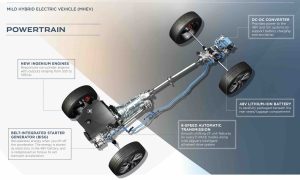
The turbocharger is a mechanical twin-scroll unit that hugs up as close to the exhaust ports as possible so as to build boost as quickly (and smoothly) as possible. But since all turbos – no matter how closely they hug the exhaust ports – are dependent on exhaust gas pressure to build boost pressure – it takes a moment for the boost to begin building.
That gap is filled by an electrically-driven supercharger that builds boost immediately.
The result is what feels like a very strong engine that isn’t turbocharged – and either 335 or 395 horsepower (and 354 or 406 ft.-lbs. of torque, respectively) depending on which version of this engine you select.
The 335 horsepower version – in the S340 – cuts the 0-60 run down to 5.8 seconds; with the 395 horsepower version – in the R Dynamic S 400 – that drops to 5.1 seconds, according to Jaguar. 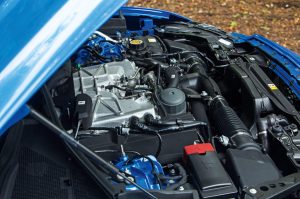
According to the EPA, the 395 horsepower version should be good for 19 city, 26 highway – which is only slightly lower than the mileage numbers posted by the standard 2.0 liter engine. And the reason for that the sixes are also mildly hybridized. A 48 volt starter-generator system cycles the engine off during deceleration, coasting and other low-load driving conditions to reduce fuel consumption.
This is not ASS – the automated top/start “technology” almost every new vehicle now comes standard (and saddled) with – that cuts off the engine when the vehicle stops moving and then noticeably re-starts it when the driver takes his foot off the brake and depresses the accelerator pedal. Those systems use the same starter motor that is used to start the car’s engine every morning – which was not designed to re-start the engine multiple times during your driving. They also rely on 12 volt electrical systems that haven’t got the power to spin that starter fast enough to re-start the engine without you feeling – and hearing – it.
The 48 volt starter-generator system has the power to spin the engine back to life so quickly – and quietly – that it’s almost impossible to tell when that just happened. Which is the whole point of the thing. Well, that and reducing fuel consumption (and emissions; a not-running engine doesn’t emit anything). And that’s what makes it possible to still offer powerful sixes like this and not just little fours.
There’s one more engine to consider.
It’s the 5.0 liter V8 that powers the very high-performance F-Pace SVR. This engine has a mechanically driven supercharger, which is powered by the engine (like an alternator or power steering pump). These “blowers” also produce immediate boost, because they don’t have to wait for the engine to build up exhaust gas pressure. They also build a lot more boost than the smaller, electrically driven “blower” used to eliminate turbo-lag with the six. But – the catch – mechanically driven “blowers” take a lot of power to make a lot of power – and that uses a lot of gas.
15 MPG city and 22 on the highway, in this case. But you do get 542 horsepower (and 516 ft.-lbs. of torque) in return.
If, of course, you can afford to indulge.
The SVR’s pushing $90k price assures only a lucky few will be able to so indulge and that is what makes it possible for Jaguar to continue offering the V8 at all.
In very limited numbers, so as to not too-badly-hurt Jaguar’s CAFE fuel economy numbers.
Oddly, if you consider it rationally, Jaguar was forced by the same government so very “concerned” about gas mileage to stop offering the turbo-diesel four the F-Pace used to be available with. This one averaged about 30 MPG – so about 5 MPG better mileage than the current gas-turbo four.
But then, that would make electric vehicles look bad – and the government is very concerned, about that.
It may look like a crossover but this one doesn’t drive like one. It drives like the rear-wheel-drive Jaguar sport sedan its crossover-shaped body was draped upon.
Most crossovers are basically front-drive cars that ride higher than the front-wheel-drive cars they are based upon. They usually offer or come standard with all-wheel-drive, as this Jaguar does – but unlike the Jag, most of the power flows to the front wheels most of the time. When they begin to slip, some is kicked back to the rear wheels. In the Jag, it’s the reverse.
What’s the difference?
To find out, put the F-Pace through some paces. Feel the way the rear wheels break traction – just a little bit and just enough to be fun – when you floor the thing from a stop at a T intersection and crank the wheel hard over. The FWD-based crossover will typically understeer skitter as it tries to recover its footing. The Jag oversteers – just a touch – and then the tail snaps back into line and off you go, a smile on your face that nothing FWD-based can induce.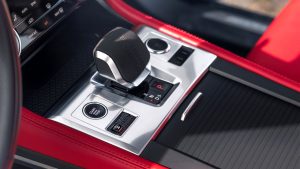
This cat is balanced – and that’s the difference – when you have the engine up front, not mounted sideways, with a tranny (not Bruce) bolted behind it, routing most of the engine’s power, most of the time, to the axle in back.
Dynamic isn’t just a mode, either. Engage it and the eight speed transmission will almost chirp the rear tires on WOT upshifts. Some reviewers say the ride is too firm for their liking, but if you like sport sedans that happen to be shaped like something else, you’ll probably like it.
The inline turbo-supercharged-mildly hybridized six that replaced the old supercharged V6 through the 2020 model year isn’t as rowdy but it’s smoother and quieter – as inline sixes usually are. It’s also lighter, which you can feel through your foot – when you put it down. The engine revs faster, not being encumbered by heavy balancers hanging off the crank, all the way to just shy of 7,000 RPM under full throttle. There’s also a 3-4 MPG bump in gas mileage vs. the old V6, which didn’t have the mild-hybrid system.
At the end of the day, though, what may matter most – if you’re into Jaguars – is that this inline six is the kind of engine that used to set a Jaguar apart from most of the others.
And now it does, again.
There are a few others that emulate the driving experience – the Porsche Macan, for instance. But Jaguar pulls another cat out of the bag by making the F-Pace a more practical experience.
It can tow 5,291 lbs., for instance – almost as much as some trucks and considerably more than the Porsche’s 4,409 lbs. It also has not far from twice the space behind its back seats – 31.5 cubic feet with them in place vs. just 17.2 for the Macan, even though the Jag isn’t appreciably larger on the outside than the Porsche.
With its backseats folded, the Jag has 69.1 cubic feet of capacity for whatever you need to carry vs. a less practical 52 cubic feet in the Macan. The lowered – almost “chopped” – roofline of the Porsche also result in less headroom in both rows than in the Jag, even with its standard panorama sunroof.
The Macan may look more dramatic but that comes at a cost.
The Rest
Jaguar kits this cat out pretty attractively, too.
A premium audio system is often extra cost, even in some $50k-plus vehicles. But it’s standard here. And it’s a really good one, too. Jaguars have Meridian systems, which some – me among them – consider to be superior to the Burmester and Bose systems installed in rivals. There’s no distortion at all at top volume. With most other systems, you usually have to dial it back just a bit to not hear audible signs of distress.
The only hair in the soup is the Jag’s pretty but clumsy curved glass LCD touchscreen interface.
These systems all have the same problem that arises when trying to tap/swipe a smartphone while you’re driving. The car moves, along with the road – and so does your finger. You tap or swap something you didn’t intend; try again. This requires some concentration – which takes yours off the road.
The F-Pace does – thankfully – have end-run mechanical inputs such as finger-wheel volume adjusters on the center console and steering wheel that make such operations less frustrating – and distracting.
Otherwise? There’s very little not to like and a lot to like – a lot.
The Bottom Line
You may need a crossover. But if you want a Jaguar, this one fills both bills.
. . .
Got a question about cars, bikes or anything else? Click on the “ask Eric” link and send ’em in! Or email me at [email protected] if the @!** “ask Eric” button doesn’t work!
If you like what you’ve found here please consider supporting EPautos.
We depend on you to keep the wheels turning!
Our donate button is here.
If you prefer not to use PayPal, our mailing address is:
EPautos
721 Hummingbird Lane SE
Copper Hill, VA 24079
PS: Get an EPautos magnet or sticker or coaster in return for a $20 or more one-time donation or a $10 or more monthly recurring donation. (Please be sure to tell us you want a magnet or sticker or coaster – and also, provide an address, so we know where to mail the thing!)
My eBook about car buying (new and used) is also available for your favorite price – free! Click here. If that fails, email me at [email protected] and I will send you a copy directly!




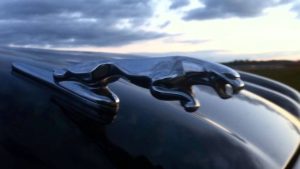

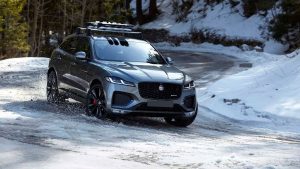
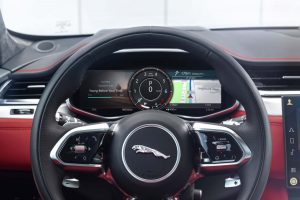









Reliability is the only big question mark with these British vehicles. They are notorious for causing issues down the road.
I see what you were saying about the curved touch-screen panel. Looks like it doubles as a convex mirror, lol!
One of my favorites. It was 2nd to the wife’s grand cherokee, and only lost cause the dealer is too far away.
Thanks for the review Eric.
I recently got one of these, but the last shape (2017). Couldnt justify double the cost for a 2021. But got the old V6 with a diesel. You’re right about this car having the lot more character than another SUV/Crossover of this class, particularly with the ability to spin the rear wheels just that little bit whenever you want it to. Even the engine sound is a lot better than german rivals (who are completely muffled now, and sound like a dyson or something when revved up). Its a shame you cant get the diesel in the US. I suspect they are trying to ban it here too – when I was gong to dealers (Summer 2021) they were not allowing orders for the new straight 6 diesel. Most dealers were saying they dont have the chips for that model so not getting quota for a build, though one told me they are trying to discourage diesel and well want to push people into the PHEV models instead for power so restricting quota for new orders of that model. Anyhow I went ahead with the old version with the V6 diesel without the MEHV and all that crap
Hi Nasir!
As you and others here know crossovers are not usually my thing. But this thing is an exception. You really do need to drive it, though, to appreciate it.
Engine choices are a big plus.
I could take or leave the hybrid system.
What I can’t get over is if I cover the badges, I would think I’m looking at a Mazda CX.
To get me to part with $50 – 85k, I need a whole lot. I don’t think a quick crossover that looks like every other crossover is it.
Mazda 5, Ford Escap’ay, Subaru CrossTrek, they are are looking the same to me nowadays.